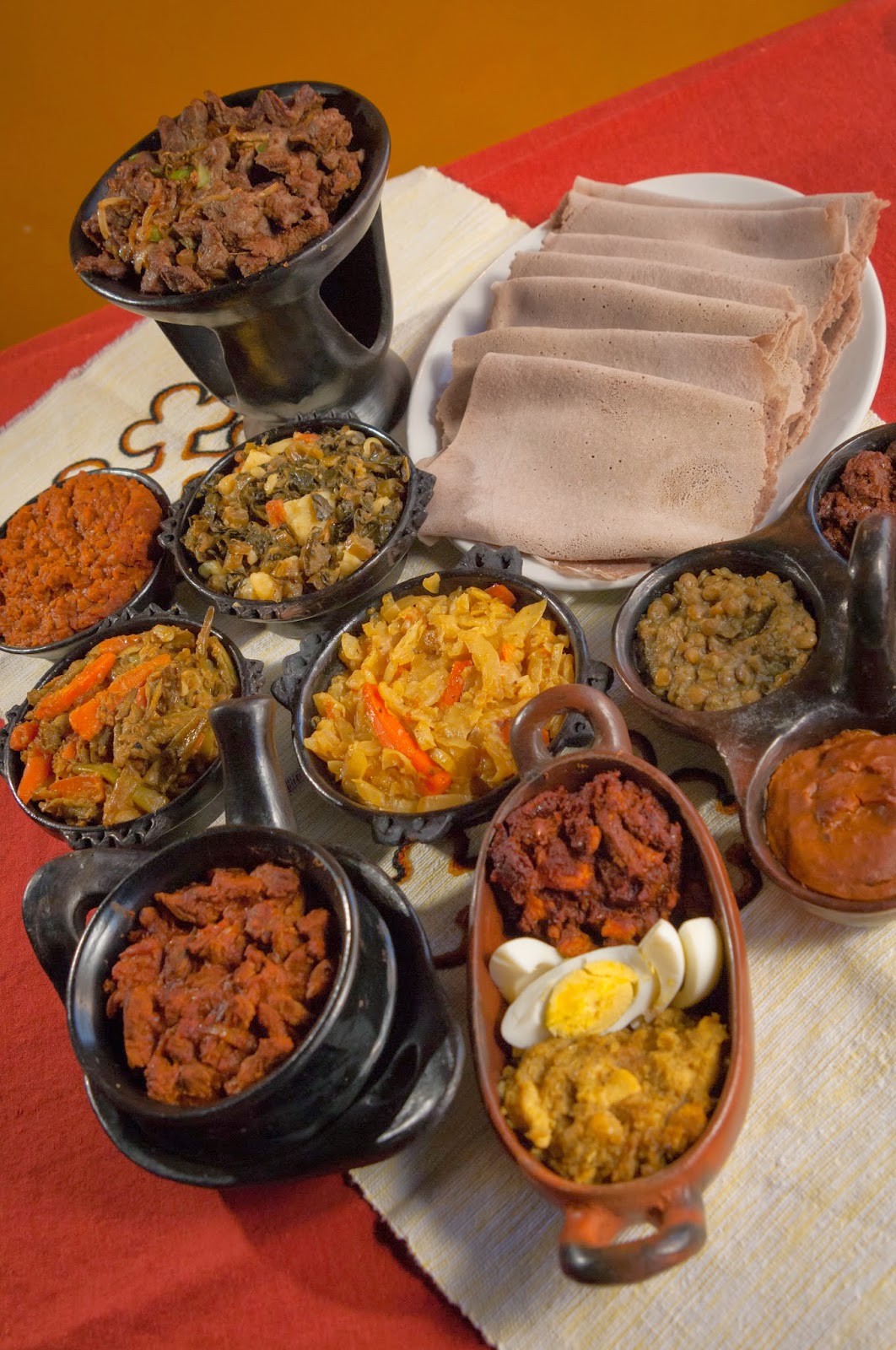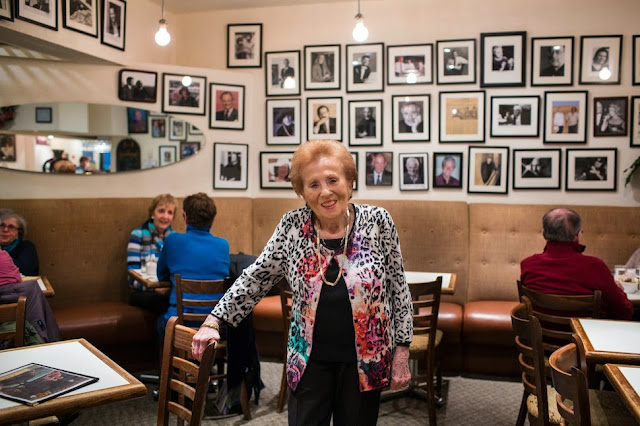Redux: Refined African Cooking at T.G.`s Addis Ababa
By BRYAN LAVERY
Dining at T.G.’s Addis Ababa is characterized by the ritual breaking of injera (the traditional yeast-risen flatbread which is spongy in texture, crèpe-like in appearance with sourdough tanginess) and sharing food from a communal platter signifying the bonds of loyalty and friendship. For more than a decade, T.G.’s Addis Ababa has offered a tour de force from the Ethiopian culinary repertoire. This is refined Ethiopian cooking.
The modest restaurant is tucked away off-the-beaten-track in an
unassuming brick building the south side of Dundas Street, near the corner of
Burwell and Maitland.
Having avoided the Eritrean – Ethiopian
conflict in 1998, with little more than determination and a leap of faith, T.G.
was eager to resettle her life in London. It was a tough route that included
being detained in the United States for five months before she received refugee
status in Canada. Initially, T.G. was employed at a variety of jobs;
attending classes to expand her English at G.A. Wheable Centre for Adult
Education and training to become a hair stylist. She dreamt of opening a
restaurant. Her passion for cooking was ignited as a child; both her mother and
grandmother were restaurateurs.
T.G. is pleased to make her home in London, “I
chose to start my business in London, but more importantly, I chose to start my
family here. It is a safe and welcoming community, and there is nowhere else I
would rather build a future.”
Ethiopian cuisine has emerged as a significant international cuisine in
recent times due to scholarly interest and the re- interpretation of complex
regional culinary traditions to create and popularize an Ethiopian national
cuisine by middle class Ethiopians in places of emigration and diaspora.
The cuisine has garnered repute for being blistering-hot, but truly
authentic Ethiopian cuisine is characterised by a blending of flavours in order
to produce a harmony of ingredients. T.G. is a skillful chef and her signature
dishes from the repertoire of Ethiopian cookery comprise permutations of sweet,
bitter, sour, salty, hot and fragrant. These flavour contrasts are the hallmark
of T.G.’s cooking.
In recent times, T.G. had hoped to bring her youngest sister to Canada
to help her with the demands and challenges of cooking a labour- intensive
ethnic cuisine that requires specialized training. Initial approval was given
to T.G.’s sister but because of her limited English there are still obstacles
with the Canadian consulate in Ethiopia. T.G. hopes this will be resolved so
that she will be able to spend more time with her young daughter. At present
she would find it difficult and uncomfortable handing over the reins of her
kitchen to an outsider. T.G. is acutely aware that there would be
consequences to employing someone who is not culturally indoctrinated in the
nuances of the cuisine.
Customarily made out of fermented tef, injera is used as both
the serving platter and eating utensil. Decorum decrees tearing pieces of
injera off with your right hand, pinching up and then wrapping it around
the meat or wat, and then popping the injera into your mouth. No other utensils
are required. Various dishes are placed decoratively and served directly onto
the injera, allowing it to absorb individual flavours and spices. Dishes are
always accompanied by additional injera to scoop up the food with.
Sharing a medley of delicious dishes that have been expertly arranged
on a common platter — the traditional way to eat — is an enjoyable
introduction to the cuisine. During a meal with
friends or family, it is a common practice to feed others in the group with
your right hand by putting the pinched up injera into another's mouth.
This is called a gursha, and I have been told that the larger the
gursha, the stronger the relationship or bond.
Berbere is the brick-red
blend of 17 ground spices which is an essential ingredient in Ethiopian cooking
and adds a fiery heat and stimulating boost to many of the dishes that reflect
its national culinary identity.
Meat dishes fall mostly into two distinct categories: red stews (wat),
which include berbere, and green stews (alicha wat), which do not. Wats
are properly prepared with a generous amount of chopped onions, which the cook
simmers or sautés in a pot. Onions are fried without oil, which gives them the
distinct taste central to Ethiopian cuisine. T.G.’s menu includes several types
of meat dishes, such as zsil zsil tibbs which are strips of beef sautéed with green onion and spices. Ethiopian cuisine
does not include pork.
Another of her signature dishes is dulet kitfo, which
consists of freshly minced, lean beef, mixed and cooked with clarified butter,
onion, jalapeño and the traditional spice mixture mitmita (a dry chili
blend containing ground cardamom seed, cloves and salt).
T.G. is a born communicator and guides the uninitiated to select from a
menu that has been designed so you can order à la carte or eat communally.
There is a large repertoire of vegetarian dishes, with a diversity of deftly
spiced preparations based on lentils, split peas, chickpeas and other pulses.
It should be noted that Ethiopian culinary staples like injera
and wat are immortalised as a metaphor for prosperity and security in the
various writings of nineteenth century travellers. Hospitality is
imperative in Ethiopia, and at T.G.’s Addis Ababa it is supreme.
T.G. is dedicated to supporting important
cultural and charitable initiatives and events despite the fact that she is a
hands-on owner who does all of the cooking at the restaurant. T.G.’s Addis
Ababa has been a stalwart participant in the Taste for Life campaign to support
the Regional HIV/AIDS Connection.
T.G. supports the efforts of local student
organizers at Brescia University during their annual Multicultural Show, as
well as the London Black History Coordinating Committee. Last year, T.G. was
selected as one of “I am London’s” successfully settled immigrants from various
countries that have chosen London as their home.
465 Dundas Street (at Maitland)
519-433-4222.








This comment has been removed by a blog administrator.
ReplyDelete